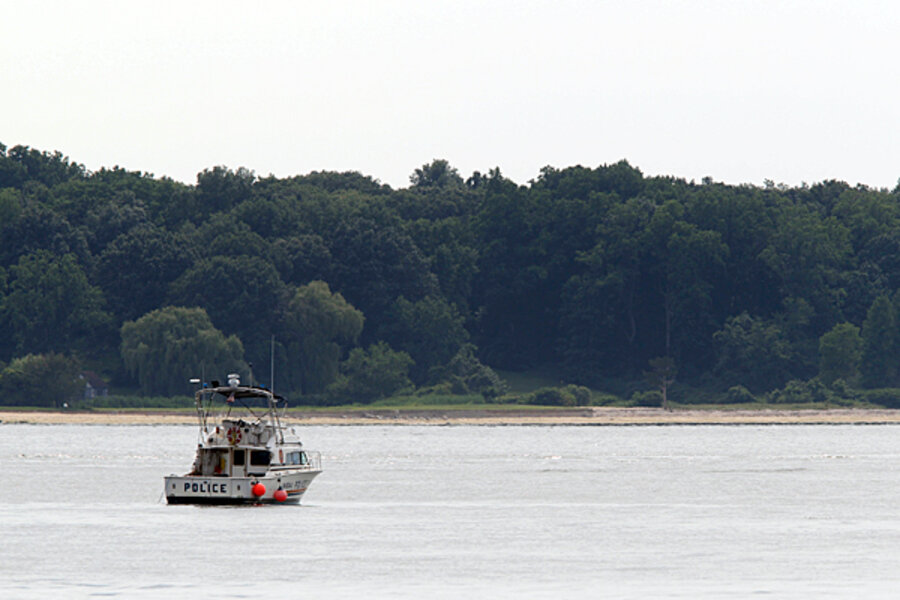Yacht accident in New York draws attention to boating safety
Loading...
| New York
Almost every year, the Dolan family, which founded Cablevision, puts on a huge fireworks display in Oyster Bay, N.Y. Scores of boaters from nearby bays and marinas anchor nearby to watch the explosions and then motor home.
However, this year, the Nassau County police are mounting an investigation after one of those boats, loaded with 27 adults and children, sank with the loss of three children. The investigation is aimed at determining what caused the boat, a 34-foot Silverton, to sink – weather issues, overcrowding, the wake of another powerboat, or some mechanical malfunction.
Moreover, the accident illustrates a disturbing problem: Boating fatalities are on the rise. According to the US Coast Guard, the main causes of fatal accidents are people not paying attention, operator inexperience, and excessive speed. These factors can lead to a main cause of death – capsizing, which is similar to what happened in Oyster Bay. In many cases, which appears to include the Oyster Bay incident, hardly anyone had on a life jacket.
The Coast Guard has considered regulatory action to mandate life-jacket wear but so far has not gone forward with the idea. The Coast Guard has also looked into requiring boaters to attend and pass boating education classes, but found that Congress has not given it authority to do so. Many states, however, now require education.
The Coast Guard does run public-service announcements on the importance of wearing life jackets and not drinking while boating.
“Lately, we’ve been emphasizing that the operator of the vessel is responsible,” says Phil Cappel of the Coast Guard’s Boating Safety Division. “That comes to question in [the Oyster Bay] situation.”
In 2011, boating fatalities rose by 12.8 percent. With the exception of 2010, the number of boating fatalities has risen every year compared with the prior year since 2007.
“We’ve been trying to move the needle [lower] and have not been successful,” Mr. Cappel says.
Viewed over a longer period of time, the safety issue is not so bad, says Gail Kulp, executive director of the Sea Tow Foundation in Southold, N.Y. “If you look at it compared to the ’80s or ’90s, it’s actually down,” she says.
Individual years can vary, she says, depending on issues such as whether the summer has “yucky” weather that keeps people off the water or gasoline prices are high, which also keeps people off the water.
According to Ms. Kulp, 47 out of 56 states and territories now require some form of training to operate a boat. In the case of New York, where the Oyster Bay accident took place, only operators of personal watercraft (such as Jet Skis) are required to take classes.
This year, Congress reauthorized the Sport Fish Restoration and Boating Trust Fund, which uses a tax on fuel bought at marinas in part to promote safe boating through public-service announcements.
Sea Tow is trying to use social media to help with boating safety, such as providing information about where people can get “loaner” life jackets. “It tells you where the closest place to your boat ramp or dock is,” Kulp says.
Of the 758 boating fatalities last year, only 12 percent of the people who died were wearing a life jacket. According to one report about the Oyster Bay incident, there were only six life jackets for the 27 people.
Some boating-safety experts have questioned how safe it was to have 27 people on a 34-foot boat.
“If I was driving that boat, I am not sure where to place those people to make it a safe situation,” says John Adey, president of the Annapolis, Md.-based American Boat and Yacht Council, which sets the standards for boat-design safety. “I don’t think the boat was designed for that kind of live load. [Twenty-seven people] would have never come into anyone’s frame of reference.”
An individual who identified himself as the controller of Silverton Yachts in Millville, N.J., said no one was available to comment since the company was in bankruptcy. He declined to give the phone numbers of any of the company’s engineers.
It’s not clear if the Coast Guard, the Nassau County police, or the Oyster Bay Constables had observed the crowded yacht before or during the fireworks event.
“We don’t have the capacity to board each vessel and can’t check on the number of people on each vessel,” says Cmdr. Christopher O’Neil, a Coast Guard spokesman in Washington. “I liken it to a traffic cop or state trooper: You can’t know the safety condition of each vehicle, but when you spot an unsafe condition, you take actions to mitigate it.”
Cappel wonders if the vessel had water in its bilge. As the boat cut through another boat’s wake, the water may have all sloshed to one side, causing it to become unstable.
“Until they bring the boat up, you just don’t know because they may have hit something or maybe a seacock gave way,” he says. “You have to look at the boat and see if there is any chance of water getting in there.”







